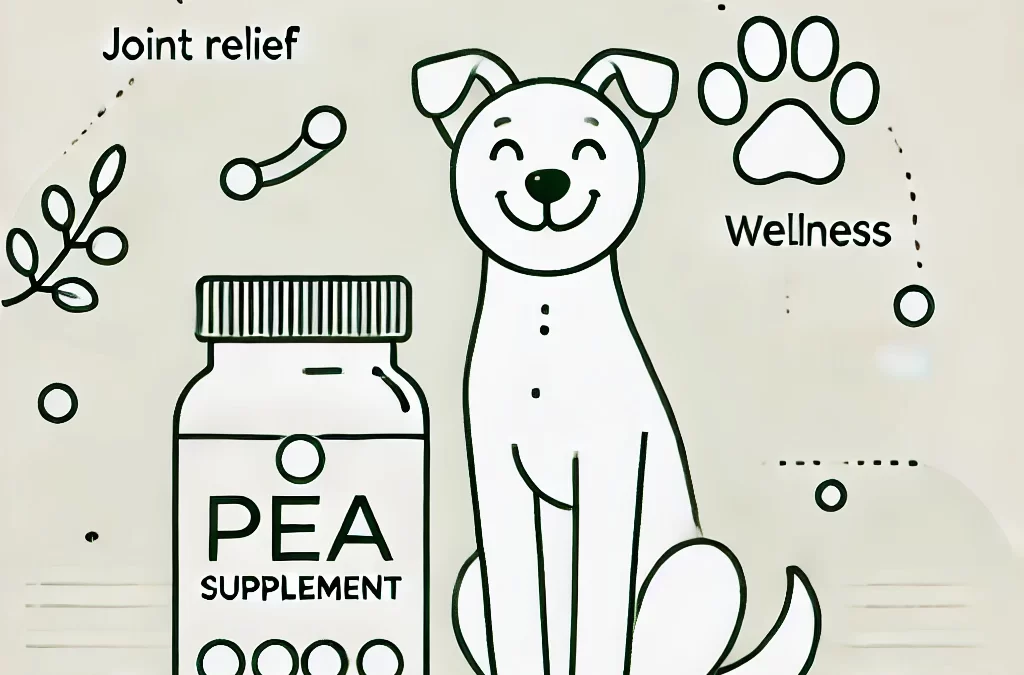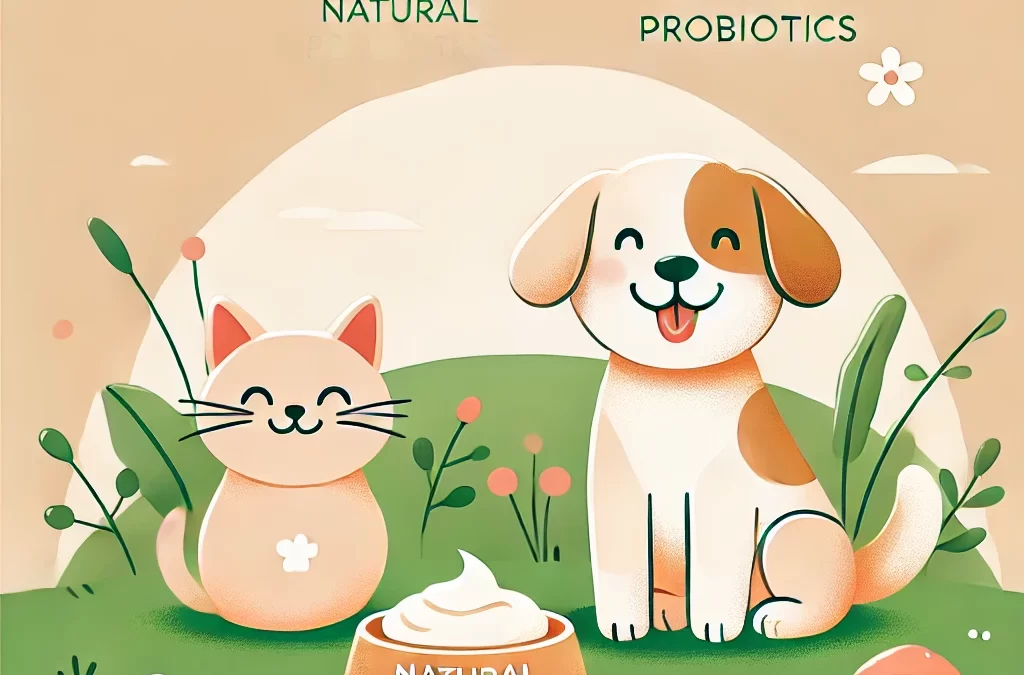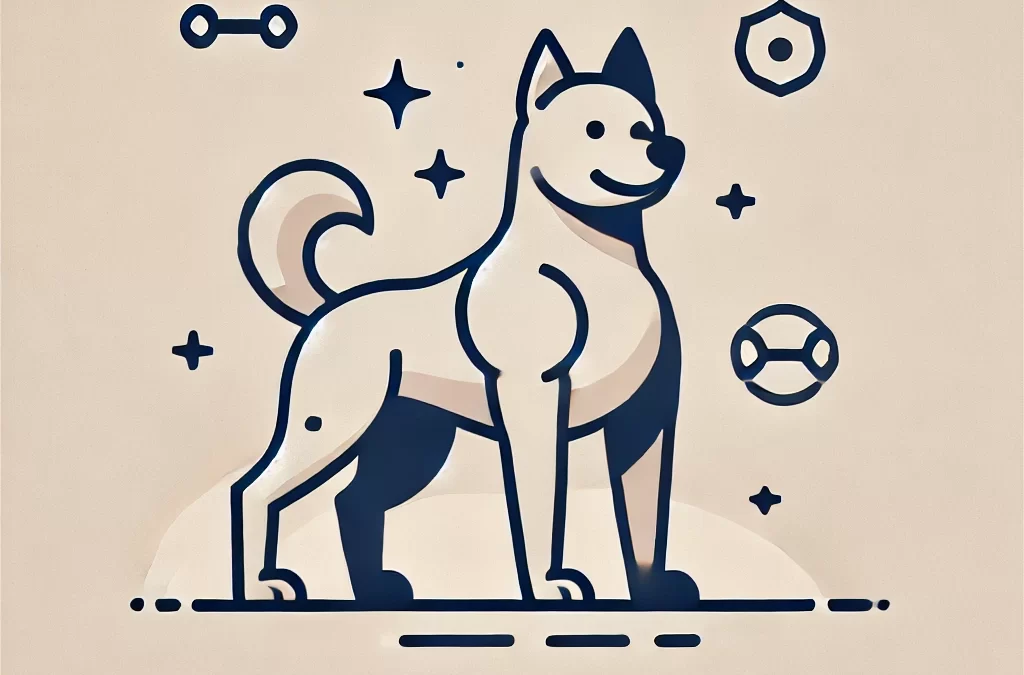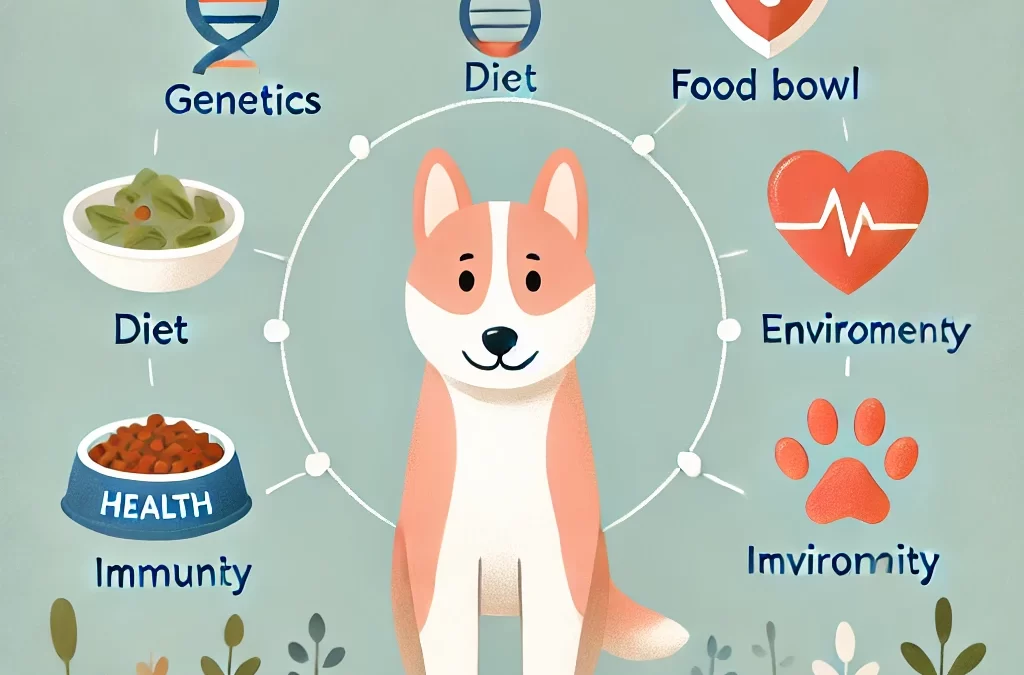
經過 TCMVET | 2024 年 11 月 13 日 | 食品與健康
棕櫚酰乙醇酰胺(PEA)因其天然的止痛和抗炎特性而在犬類護理領域越來越受歡迎。 PEA 最初被發現是一種人體產生的脂肪酸醯胺,是一種類似內源性大麻素的化合物,存在於各種組織中,包括大腦和免疫系統。這種獨特的化合物存在於雞蛋和大豆等食物中,在支持人類和動物的疼痛管理和減少發炎方面顯示出潛在的益處。但這對我們的犬類夥伴意味著什麼呢?
什麼是 PEA,為什麼它對狗有用?
PEA 在人類和狗體內自然產生,作為對發炎和疼痛的反應。作為一種內源性化合物,PEA 與內源性大麻素系統協同作用,幫助調節發炎和疼痛感知,而不會產生精神影響。與傳統藥物相比,這使其成為寵物更安全的替代品,尤其是長期使用。
PEA 對狗狗的主要好處:
- 緩解疼痛: PEA 與神經系統中的受體相互作用,提供了一種減少不適的自然方法。
- 抗發炎特性: 它作用於身體的免疫反應,減少炎症,這對患有關節炎、皮膚炎和其他炎症的狗有益。
- Improved Quality of Life: 透過減輕疼痛和炎症,PEA 可以改善活動能力、能量水平和整體健康。
PEA 如何發揮作用?
與其他止痛藥不同,PEA 不會直接阻斷疼痛訊號。相反,它作用於所謂的“隨行效應”,增強調節疼痛和發炎的自然過程。下面簡單介紹一下它的運作原理:
- 與大麻素受體的相互作用:PEA 間接與免疫系統中的大麻素受體(CB2 受體)相互作用,促進平衡的免疫反應。
- 抑制發炎酶:它抑制促進發炎的酶,使身體的自然癒合過程更有效地發揮作用。
- 肥大細胞穩定:PEA 可以穩定肥大細胞,肥大細胞是針對損傷或發炎釋放組織胺的免疫細胞,減少與發炎相關的不適。
PEA 可以幫助狗狗治療哪些病症?
PEA 可能有益於患有多種慢性病的狗:
- 關節炎:它的抗發炎作用可以幫助患有關節發炎和僵硬的狗。
- Skin Conditions:患有慢性皮膚炎的狗可能會減輕搔癢和刺激。
- 神經系統疾病:一些研究表明,PEA 可以透過鎮靜過度活躍的神經細胞來幫助狗狗緩解與神經相關的疼痛。
- 術後恢復:PEA 的鎮痛特性可能有助於術後更快的恢復和疼痛管理。
安全使用 PEA:劑量與注意事項
PEA 通常具有良好的耐受性,但遵循安全的方法至關重要:
- 諮詢獸醫:在將 PEA 引入您的狗的日常生活之前,請務必先諮詢獸醫,尤其是當它們正在服用其他藥物時。
- 慢慢開始:引入較小劑量的 PEA 並監測是否有任何反應。 PEA 通常有片劑、粉末或咀嚼片形式,建議劑量依體重而定。
- 觀察和調整:監測您的狗的反應,在獸醫監督下根據需要調整劑量。
為您的狗選擇合適的豌豆補充劑
並非所有 PEA 補充劑都是一樣的。選擇 PEA 產品時,請注意:
- 純度和質量:選擇經過純度測試且不含污染物的補充劑。
- 微粉化形式:這種形式的 PEA 具有更高的生物利用度,這意味著它可以更有效地被狗的系統吸收。
- 狗狗專用產品:有些品牌專門為寵物設計 PEA,確保正確的劑量和配方。
最後的想法:PEA 在寵物護理領域的未來
隨著越來越多的寵物主人尋求天然的選擇來改善他們的狗的生活,PEA 脫穎而出,成為一種有前途的補充。其緩解疼痛和發炎管理的多方面方法可以使衰老的寵物、患有慢性疾病的寵物以及任何需要安全、溫和的健康支持的狗受益。
隨著研究的不斷深入和寵物專用配方的增多,PEA 可能很快就會成為整體寵物護理的主要成分。其獨特的機制和經過驗證的安全性使其成為可行的創新選擇,可支持狗的舒適度和活力,且沒有傳統藥物的副作用。

經過 TCMVET | 2024 年 11 月 13 日 | 食品與健康
就像人類一樣,寵物可以從益生菌中受益匪淺,益生菌是支持腸道健康、免疫力和整體健康的「好細菌」。雖然商業益生菌很受歡迎,但益生菌的天然來源正在成為一種有效且全面的方法。本文深入探討什麼是天然益生菌、在哪裡可以找到它們,以及它們如何自然地增強寵物的健康。
1. 什麼是寵物天然益生菌?
- 定義:天然益生菌是在天然發酵食品、草藥和植物中發現的活的有益細菌。
- 它們是如何工作的:這些微生物有助於平衡腸道微生物組、改善消化、增強免疫反應,甚至對情緒產生正面影響。
- 與商業益生菌的區別:天然益生菌源自天然食品,加工較少,提供更接近自然的解決方案。
2. 天然益生菌對寵物的好處:
- 更好的消化:益生菌可以幫助分解食物、吸收營養並減少脹氣或腹瀉等消化問題。
- 更強的免疫力:平衡的腸道微生物群可以增強免疫系統,幫助寵物更有效地抵抗感染。
- 緩解過敏:定期攝取益生菌可以透過減少腸道發炎來緩解皮膚過敏,腸道是許多免疫反應的發源地。
- 情緒和行為:研究顯示腸道健康與情緒之間存在聯繫,表明益生菌可以對寵物產生鎮靜作用。
3. 寵物用天然益生菌的來源:
- 優格和克菲爾:原味、不加糖的優格和克菲爾富含益生菌,例如 嗜酸乳桿菌 和 雙歧桿菌。如果少量、安全地服用,這些可以支持消化健康。
- 酸菜:少量發酵蔬菜,如酸菜(無鹽)可以提供益生菌,但應謹慎添加。
- 蘋果醋:生蘋果醋含有酵素和有益細菌,但使用前應稀釋,以防止消化不良。
- 草藥和土壤生物:某些草藥如蒲公英根和菊苣根含有益生元,可以滋養有益細菌。此外,在寵物安全的有機土壤中發現的土壤益生菌可以自然地支持腸道健康。
4. 如何在寵物飲食中添加天然益生菌
- 從小事做起:少量服用並監測是否有任何消化不良或反應。
- 觀察和調整:如果您的寵物似乎受益,請按照獸醫的建議逐漸增加頻率或數量。
- 一致性是關鍵:定期、一致劑量的天然益生菌往往會產生最佳效果,因此請找到適合您寵物日常生活的方法。
5. 何時考慮天然益生菌而不是補充劑
- 對於敏感的寵物:無法很好地耐受商業益生菌補充劑的寵物可能對天然來源有更好的反應。
- 抗生素後治療:經過一輪抗生素治療後,天然益生菌可以幫助恢復腸道微生物組。
- 日常健康保養:如果您正在尋找預防方法,天然益生菌可能是一種溫和、有效的日常健康選擇。
6. 安全提示和注意事項
- 避免添加劑:堅持使用原味、無味和不加糖的益生菌來源,因為糖和人工香料等添加劑可能會傷害寵物。
- Consult Your Vet:請務必諮詢您的獸醫,特別是如果您的寵物有任何潛在的健康問題或過敏。
- 監測副作用:在極少數情況下,寵物的系統適應新的益生菌時可能會出現輕度腹瀉或腹脹。
結論:
天然益生菌提供了一種全面的方法來促進寵物的健康,支持消化、免疫力甚至情緒。透過引入安全、天然的益生菌來源,您可以提供更自然的健康之路。只要有耐心和堅持,這些天然的幫手就可以成為您的寵物日常生活中的重要組成部分,讓您的寵物過著更快樂、更健康的生活。

經過 TCMVET | 2024 年 11 月 13 日 | 狗癌症和腫瘤
脂肪塊或脂肪瘤是狗狗最常見的非癌性生長之一,尤其是隨著年齡的增長。寵物主人發現這些腫塊時常常會感到警惕,但大多數脂肪瘤是良性的。在本文中,我們將探討這些腫塊的感覺,如何將它們與其他腫塊區分開來,以及何時諮詢獸醫的提示。
1.什麼是脂肪塊?
- 脂肪瘤的定義:脂肪瘤是在皮下形成的柔軟脂肪沉積物,通常發生在老年或超重的狗身上。
- 常見地點:通常出現在軀幹、腋窩和四肢,但也可以出現在不同位置。
- 原因:雖然確切原因尚不完全清楚,但可能與年齡、品種、遺傳和體重有關。
2. 脂肪塊的感覺:
- 柔軟可動:脂肪瘤通常很軟,略顯濕軟,感覺有點像皮膚下的一團麵團。只要輕輕一推,它們就很容易移動,這通常將它們與堅硬、移動性較差的植物區分開來。
- 不痛:與囊腫或膿腫不同,脂肪瘤不會引起疼痛,除非它們壓迫神經或關節。
- 質地一致:脂肪瘤通常整體感覺相同,具有均勻的麵團狀質地。
3. 脂肪瘤與其他類型腫塊的區別:
- Cysts:囊腫通常較堅硬,充滿液體,有時有一個中央淚點,與脂肪瘤的均勻性不同。
- 膿腫:這些通常是疼痛的,摸起來感覺溫暖,通常伴隨發紅。
- 癌症:惡性腫塊感覺較硬,通常固定在原位,並且可以快速或不規則地生長。腫瘤的形狀可能不規則或堅硬。
- 纖維瘤:這些良性腫瘤比脂肪瘤感覺更堅硬,移動性較差,但通常是無害的。
4. 什麼時候該擔心?
- 成長率:如果腫塊快速生長、改變形狀或變得疼痛,最好立即諮詢獸醫。
- 位置問題:關節附近或影響活動能力區域的腫塊可能需要移除或監測。
- 多個腫塊:多發性脂肪瘤在某些品種中很常見,但如果迅速出現新的腫塊,請考慮進行獸醫檢查。
5. 診斷脂肪瘤:
- 獸醫檢驗:獸醫可以透過觸診確認腫塊是否為脂肪瘤。
- 細針穿刺切片檢查 (FNA):為了獲得更明確的診斷,FNA 可以從腫塊中收集細胞進行分析,從而明確腫塊是否為良性或需要進一步檢查。
6. 脂肪瘤應該切除嗎?
- 當需要手術時:一般來說,除非脂肪瘤引起不適、限制活動或過度生長,否則應將其置之不理。
- 微創選擇:在某些情況下,較新的方法,如抽脂或類固醇注射,可能有助於減少脂肪瘤。
7. 減少脂肪瘤的預防與健康秘訣:
- 保持健康的體重:肥胖是脂肪瘤的已知危險因子。
- 定期檢查:定期拜訪獸醫可以及早發現和監測任何新的生長。
- 均衡飲食與運動:均衡飲食和持續運動有助於預防肥胖,從而降低脂肪瘤的可能性。
結論: 雖然狗身上的脂肪塊可能令人擔憂,但它們通常是無害且易於管理的。透過了解脂肪瘤的感覺、原因和症狀,狗主人可以對其寵物的健康做出明智的決定。如果您不確定您的狗身上是否有腫塊,請務必尋求專業建議以獲得安心。

經過 TCMVET | 2024 年 11 月 12 日 | 狗癌症和腫瘤
對於希望幫助他們的狗發展肌肉、增強力量或從受傷中恢復的寵物主人來說,增肌補充劑的想法可能看起來很有趣。雖然不是每隻狗的標準,但這些補充劑可以使某些品種、高能量狗、工作犬甚至正在康復的狗受益。在這裡,我們將探討狗狗肌肉增強補充劑的好處、需要尋找的關鍵成分以及選擇安全有效產品的技巧。
1. 為什麼肌肉對狗很重要
健康的肌肉系統對每隻狗都至關重要,而不僅僅是活躍或運動的狗。肌肉有助於支撐關節、提高耐力並維持整體活動能力。對於參與敏捷、狩獵或其他高強度活動的狗來說,強壯的肌肉可以幫助防止受傷並提高表現。此外,年長的狗、從手術中恢復的狗以及患有關節炎等某些疾病的狗可以從肌肉支持中受益,以保持力量並減少不適。
2. 誰應該考慮增肌補充劑?
並非所有狗都需要增肌補充劑,但它們可能有益於:
- 活躍品種: 邊境牧羊犬、德國牧羊犬和拉布拉多犬等品種天生精力充沛,並且透過結構化的日常運動而茁壯成長。
- 工作犬: 警犬、軍犬和服務犬通常需要增強體能。
- 高級犬: 隨著時間的推移,衰老的狗會失去肌肉質量。補充劑可以幫助維持肌肉張力,從而支持關節健康。
- 康復中的狗: 從手術或受傷中恢復的狗可能需要額外的支持來重建力量和活動能力。
3. 尋找的關鍵成分
並非所有的增肌補充劑都是一樣的,因此了解成分的好處有助於選擇優質產品。以下是可以支持肌肉健康的頂級成分:
- 胺基酸: 蛋白質、左旋肉鹼和左旋谷氨酰胺等胺基酸的組成部分有助於肌肉發育和恢復。這些對於狗狗建立或保持瘦肌肉至關重要。
- 肌酸: 雖然肌酸通常與人體健美有關,但它是一種天然化合物,可以幫助狗狗提高肌肉表現。它對於短時間的能量爆發特別有益,例如短跑或敏捷性訓練。
- Omega-3 脂肪酸: 眾所周知,這些健康脂肪可以減少炎症,有助於運動後的恢復。 Omega-3 還可以支持關節健康,使其成為肌肉補充劑的良好補充。
- 蛋白質來源: 雞肉、魚或牛肉等優質蛋白質來源為肌肉生長和修復提供必需的營養。一些增肌補充劑含有脫水蛋白粉。
- 關節支持化合物: 葡萄糖胺和軟骨素等成分並不直接用於增強肌肉,但它們支持關節健康,這對於想要增強和維持肌肉的活躍狗來說至關重要。
4. 選擇正確的增肌補充劑
選擇補充劑時,請考慮以下提示,以確保為您的狗提供最安全、最有效的產品:
- 選擇狗狗專用產品: 一些人類肌肉增強補充劑可能對狗有害。尋找專門針對犬類生理學配製的產品。
- 檢查優質成分: 填充劑、人工香料或防腐劑越少越好。好的補充劑應該富含完整成分。
- 與您的獸醫交談: 在開始任何補充劑之前,請諮詢您的獸醫,特別是如果您的狗有任何既往健康狀況。
- 慢慢開始: 逐漸引入任何新的補充劑,觀察您的狗的反應,並避免給予超過建議劑量。
5. 補充劑與自然飲食
雖然補充劑可以提供一種促進狗狗肌肉健康的便捷方法,但均衡飲食是基礎。高蛋白飲食,包括瘦肉、雞蛋和一些魚,自然可以支持肌肉健康。補充品與良好的營養和適當的運動相結合是最有效的。
6. 透過鍛鍊和訓練增強肌肉
僅靠補充劑無法增強肌肉;結構良好的鍛鍊程序至關重要。專注於涉及整個身體的活動,例如:
- 負重步行或健行: 安裝一個輕便的背包可以為健康的狗提供溫和的抵抗力。
- 敏捷性訓練: 鼓勵靈活性並增強力量,同時保持您的狗的精神刺激。
- 游泳: 游泳是一種低強度的運動,對於肌肉生長和關節健康非常有益。
結論:培育一隻更強壯、更健康的狗
對於需要增強力量的狗狗來說,增肌補充劑可能是一種有價值的補充,但只有與均衡的營養和運動相結合才能發揮最佳效果。透過仔細選擇高品質的補充劑並讓您的獸醫隨時了解情況,您可以支持您的狗的肌肉健康,確保它們保持活躍、強壯,並為人生的冒險做好準備。

經過 TCMVET | 2024 年 11 月 12 日 | 狗癌症和腫瘤
癌症對人類和寵物來說都是最具挑戰性的疾病之一,當它影響到我們心愛的狗時,尤其令人心碎。但了解狗狗罹患癌症的原因和方式可以為預防提供線索,並為早期檢測提供見解。雖然沒有萬無一失的預防癌症的方法,但讓我們探討一下主要的影響因素、新興研究以及我們可以幫助降低風險的方法。
1. 遺傳學:品種和家族史的影響
有些品種更容易患癌症。例如,金毛尋回犬、拳師犬和羅威納犬等品種在基因上傾向於某些癌症。研究表明,遺傳性基因突變在這些傾向中發揮重要作用。發表在的一項研究 犬遺傳學和流行病學 研究表明,特定品種具有共同的遺傳特徵,使它們更容易患腫瘤。因此,狗的血統會增加其風險,這意味著某些品種的寵物父母需要格外警惕,定期進行獸醫檢查。
2. 環境因素:致癌物質和日常毒素
狗狗和人類一樣會接觸環境毒素。常見的罪魁禍首包括二手菸、某些清潔產品、殺蟲劑和污染。狗與地板和室外表面密切接觸,很容易攝入或吸入有害物質,在不知不覺中將毒素帶入體內。還有越來越多的證據表明,接觸特定致癌物與狗患癌症風險增加之間存在直接相關性。
可行的見解: 為了盡量減少接觸,請考慮選擇天然清潔產品,避免在寵物周圍吸煙,並確保您的狗的遊樂區沒有農藥。
3. 飲食:營養在癌症預防中的作用
狗吃的東西會對它們的健康產生深遠的影響,影響從免疫功能到細胞健康的各個方面。填充劑和人工添加劑含量高的劣質食品可能會導致細胞突變和炎症,從而可能導致癌症。另一方面,富含抗氧化劑、歐米茄脂肪酸和天然蛋白質的均衡飲食可以支持細胞修復和免疫防禦。
飲食建議: 考慮改用高品質、有機的甚至是自製的食物,以滿足您的狗的營養需求。請務必諮詢獸醫以獲得最佳飲食的指導。
4. 荷爾蒙影響與生殖健康
荷爾蒙是體內強大的化學信使,它們可以影響腫瘤的生長。研究表明,在適當的年齡進行絕育可以降低某些癌症的風險,例如乳癌或睪丸癌。然而,這些手術的時機至關重要,因為早期絕育會增加其他癌症(例如骨肉瘤)的風險增加。
平衡決策: 與您的獸醫討論為您的狗進行絕育或絕育的最佳時間,因為時間可能會根據品種和個人健康狀況而有所不同。
5. 感染和病毒
已知某些感染和病毒具有致癌性。在狗身上,犬乳突病毒等病毒會引起疣,在極少數情況下可能會發展成惡性腫瘤。此外,引起慢性發炎的感染會隨著時間的推移導致細胞變化和突變,可能導致癌症。
6. 衰老:不可避免的因素
年齡是狗狗罹患癌症最重要的危險因子之一。隨著獸醫護理的改善,狗的壽命越來越長,隨著年齡的增長,癌症的可能性也會增加。隨著狗的細胞老化,修復 DNA 損傷的機制可能會變得效率較低,更容易發生癌性突變。
預防措施和改變生活方式以實現更健康的生活
雖然並非所有癌症病例都是可以預防的,但某些生活方式的調整可以幫助降低風險。以下是一些可以促進長期健康的預防措施:
- Routine Veterinary Care: 定期檢查有助於發現任何異常生長或早期預警信號。
- 健康飲食選擇: 選擇富含必需營養素、不含人工添加物和填充劑的食物。
- 保持環境清潔: 使用無毒產品並避免讓您的狗接觸有害化學物質。
- 規律運動: 保持狗狗活躍可以支持強大的免疫系統,這對於抵抗疾病至關重要。
結論:知識是我們最好的防禦
了解導致狗狗罹患癌症的因素可以幫助我們做出明智的選擇,並在可能的情況下降低風險。雖然遺傳和年齡是我們無法控制的,但我們可以採取措施確保我們的狗過著更健康、更長壽的生活。透過保持警惕、優先考慮優質護理並營造無毒環境,我們可以為我們的狗提供無癌症生活的最佳機會。





